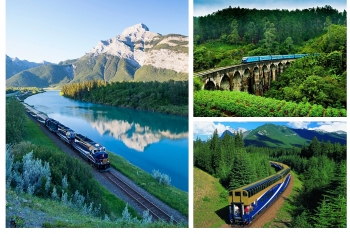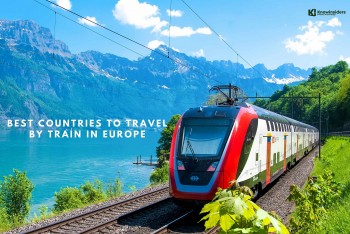Why Does The US Have No High-Speed Trains?
| Contents |
True high-speed trains are nonexistent in the US save for the Acela line in the Northeast Corridor. The Acela line allows speeds of up to 150 mph for just 34 of its 457 miles. It averages about 65 miles per hour between New York and Boston. When compared to the rates that trains are already traveling at, this is incredibly slow. Is the reason ever a mystery to you?
American High-Speed Rail's Grand Promise
It could be easy to give up on these projects given all the problems they've encountered. The potential of high-speed rail, however, is too great to ignore, according to its advocates. The use of high-speed rail holds great promise as it can transport Americans more quickly and with less environmental impact compared to driving, flying, or conventional rail. Also, less traffic and cleaner air would result from fewer drivers on the road.
Also, by linking them to urban centers, high-speed rail may resuscitate economically depressed suburbs and cities that have fallen behind. According to studies, high-speed rail stations can have a direct impact on increases in GDP. Commuter hubs are the goal of the Boston–New York route, which aims to transform post-industrial towns. Housing costs and population density in crowded metropolitan areas would both go down as a result of this.
 |
| Why Does The US Have No High-Speed Trains? |
READ MORE: Top 10 Most Beautiful Train Routes for Discovering in the World
How come the United States isn't using high-speed rail?
There are 5 main reasons why the US does not have high-speed trains.
Density of population
Looking down on a clear day when flying across the US will make you notice how vast and distinct it is compared to most of Europe and Asia. While cities in other parts of the world tend to be more compact, even our densest metropolis exhibit more "suburban sprawl" than their European and Asian counterparts. As an example, the population density of Hebei province—which is not even thought of as very dense in China—is more than that of Dallas, our fourth-largest metropolitan area. Among the many obstacles to high-speed commuter rail's financial viability, this is likely the most significant.
Suburban sprawl vs. Town squares
The majority of Americans reside in suburban areas, where huge expanses of land characterized by single-family homes stretch for miles (a phenomenon known as "suburban sprawl"). While this is the case, think about how most European cities and villages were laid out in the pre-automobile era. Back then, people mostly used "your feet" as a means of mobility. As a result, mixed-use development strategies—like the classic European village or town square—are becoming more popular, with residential and commercial areas situated side by side.
Because of this, the location of the train station becomes a contentious issue for the majority of Americans, complicating what should be a simple decision.
The right to own property
Securing land along a somewhat straight path is one of the most expensive components of establishing new rail lines these days. Run trains at high speeds along too sharp of a bend, of course. Land acquisition is extremely costly in the United States due to the country's robust property rights. When land was more affordable, the United States had little trouble laying railroad tracks across the nation.
Land in China is still mostly under state control, making it relatively easy to secure.
Culture
Free will and autonomy are highly prized by the American people. What this suggests is that local news is more important to Americans than national news. They feel uneasy or even hostile against contributing financially to large-scale public works projects such as high-speed rail. You can try to convince the average American that high-speed rail is necessary and that they should be prepared to pay more in taxes to pay for it, but they won't listen. No matter how many people stand to gain from it, it runs counter to our cultural norm of sharing in the fruits of our labor by paying taxes.
The automobile is also very important in American culture. Having a car is a huge deal for people of all ages in the United States, but it's especially significant for young people. It would be unbearable for many American adults to live without their cars. Except in very congested coastal cities with very little land space, almost no adults use just public transportation to get around. Things may begin to shift, though, once gas prices spike.
High cost
Construction of infrastructure projects in the United States is far more expensive than in any other country. Unions are being blamed by the right, while expensive consultants are being blamed by the left. However, instead of addressing the underlying cause, they are all fixated on the symptom. The factors I mentioned before, along with a fair amount of federalism, are responsible for the high expense of the transportation infrastructure in the United States.
Instead than staring at the inflated figures, read any essay lamenting the cost of American infrastructure, like Brian Rosenthal's 2017 mammoth for the New York Times. Then, consider why U.S. infrastructure projects employ so many consultants, union featherbedders, the likes.
The answer is that they are there to prevent more litigation, make sure the government complies with regulations set by other agencies, or satisfy influential lobbyists. There are a number of lobbies that need to be satisfied when large infrastructure projects include numerous governments, none of which has final control over the project.
Of course, crony capitalism exists in other nations as well. However, one drawback of our extremely decentralized government is that it allows practically anyone to assemble a group of cronies and gain the ear of a politician. This is because a lot of power is pushed down to smaller, more locally responsive governments.
High-speed Train Will Not Go in the Direction You DesireActually, there were six separate and unrelated systems that made up the 8,600-mile high-speed rail network that the Obama administration planned. There was no intended direct route connecting Chicago and Kansas City, even within each system; however, passengers could travel to St. Louis and Kansas City from St. Louis. Just a handful of these issues would be addressed by the proposed high-speed rail system by USHSR. A 220 mph route from Chicago to Kansas City, for instance, is still missing from it. Several cities with populations of over 500,000 are not serviced by the 220 mph network, while numerous cities with populations of over 100,000 are not serviced by the 110 mph network either. From any exit on an interstate expressway, drivers have access to the remaining 4.1 million miles of roadways in the country. The system's convenience is significantly diminished once rail passengers reach a station; they are then need to arrange for alternative modes of transportation to reach their ultimate destinations. |
Will Americans use high-speed trains if they are built?
Among Americans, 63% would take use of high-speed rail if it were accessible, according to a survey. Most of all, the younger generation wants it. Amtrak is currently the most popular choice for passenger rail in the United States. The federal government holds the majority of the shares in this for-profit business, while it is run by private individuals. In the context of trains, only one of Amtrak's lines may be deemed high-speed, since it reaches top speeds of over 110 to 150 mph. The Northeast Corridor connects Washington, D.C., New York, and Boston, and that's its Acela line.
READ MORE: Top 10 Oldest Train Stations in The World You Should Visit
High-speed train network around the worldPassengers in Asia and Europe may now travel longer distances faster than ever before thanks to high-speed rail. Trains can reach speeds of over 125 mph on high speed rail routes. The train's speed can be affected by curves, inclines, and the age of the tracks, even though current tracks can be used. The bullet train, or shinkansen, of Japan can reach speeds of up to 320 mph and covers the whole country. The 300-mile journey from London to Paris takes less than two hours by train. The DC-NYC Acela is the United States's only high-speed rail option; it can reach speeds of up to 150 mph but typically travels at around half that speed owing to the lines' age. Innovative technologies, such as the Shanghai Maglev, which has a record-breaking speed of 373 mph, have the potential to increase maximum speeds even further. Maglev could potentially enhance safety while decreasing maintenance expenses. |
In conclusion
High-speed rail is an expensive and out-of-date method of transportation. Compared to flying and driving, it is slower and less convenient, and it costs more. The environmental benefits of this are, to put it mildly, dubious, particularly considering the annual improvements in fuel efficiency and pollution levels of both cars and airplanes.
It is unnecessary to construct a costly new infrastructure system in the US that will take decades, transport few people, and do little to enhance freight service.
 Top 10 Most Interesting Train Journeys To Travel the World Top 10 Most Interesting Train Journeys To Travel the World Relaxing in a spacious seat on a train and taking in the passing landscape can be a thrilling experience, providing ample time for thought and ... |
 The World's Top 10 Most Gorgeous Train Stations The World's Top 10 Most Gorgeous Train Stations Train travel has long been a well-liked method to explore the nation and discover destinations we might not have otherwise known about. The ten most ... |
 Top 10 Most Beautiful European Countries To Travel By Train Top 10 Most Beautiful European Countries To Travel By Train Have you ever taken a train on a lengthy trip? Traveling by train is a very happy experience. See the list of the top ten ... |
























